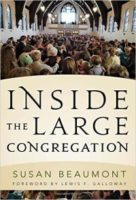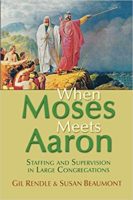Who speaks for the congregation’s soul? When it comes to discerning mission, vision and strategic direction, who gets to name the congregation’s giftedness and vocation? Is it the senior clergy leader, the governing board, the congregation, or someone else?

By the congregation’s soul, I mean the source of its calling, character, and destiny—the charism, the bedrock where its sacred memories reside. Who speaks for soul?
Pastor Craig is a young and vibrant clergy leader with many fresh ideas that have not yet coalesced into vision. He and the congregation have successfully negotiated an eighteen-month honeymoon period. Now the people are growing restless.
Many are looking to Craig to articulate what the next chapter will hold. At the most recent board meeting, leaders suggested that Craig should exert stronger leadership, that he is the “one” who should articulate the vision for the next season. Leaders want their pastor to discern and speak on behalf of the soul of the congregation and declare a new direction, one they say they will gladly follow.
What would you do if you were in Craig’s shoes? Is this his job as the senior clergy leader, or is this request a set up for later scapegoating and blame if the vision doesn’t ring true? Craig values participative leadership and would like the discernment to incorporate wider input, but he fears that he is shirking pastoral responsibility if he doesn’t have a personal vision to assert.
Within scripture there are various models for how a community listens to its soul and discerns and decides upon vision and direction. Let us explore three of these models and consider the pros and cons of each approach.
Let Moses Decide
The leaders of Craig’s church are asking for authoritative leadership. They want him to emulate the leadership of Moses. They are seeking clear and decisive direction from someone they believe has more direct access to the soul of the institution than they do.
When the time was right for the Hebrew people to leave Egypt, Moses did not pause to ask the people how they wanted to leave, or which way they wanted to go. Moses climbed Mt. Sinai and encountered Yahweh, and Yahweh spoke on behalf of the community. Moses told the people in no uncertain terms what God had directed them to do. The people complained, but they followed the directions given.
Authoritative leadership is decisive and quick. As soon as the leader knows, the collective whole can be marshaled to follow, if they are truly ready and willing to follow. This model of vision-setting carries the biggest potential for rejection. People love following Moses as long as the Promised Land remains in sight and things don’t get too dicey.
Authoritative leadership works best when the leader demonstrates clear expertise and when the leader has deep reservoirs of influence capacity. A reservoir of trust will carry the leader and the group through inevitable periods of trials and resistance. Authoritative leadership works well in crisis seasons, or when the community is still in formative stages.
Craig may encounter problems with this style of leadership on two fronts. First, his influence reservoir may not yet be deep enough to pull it off. Second, his church embraces a congregational form of governance. They value the voice of each individual and they honor democratic principles and processes. They want Craig to act in a way that is inconsistent with their polity. Craig should be worried about the disconnection between what his leaders are asking for and their governance practice.
Let the Leaders Lead
A second model places the responsibility for discernment in the hands of a small group of designated leaders. We can look to the Jerusalem Council in the book of Acts as an example of this form of leadership.
Early in the book of Acts, we learn that community leaders are struggling with group decision making. Can gentiles be practicing members of the community, and do they need to follow Jewish customs and rituals in order to participate? The leaders of various factions gather in Jerusalem to discern what the soul of the nascent movement requires. Through a process of dialogue and narrative story-telling the participants at the Jerusalem Council work towards consensus.
Applied to a congregational setting, this model of leadership recognizes the lead pastor as one voice among equals. A community emulating the Jerusalem Council would look to their governing board, or a group appointed by the governing board, to discern on their behalf.
Discernment takes longer in a group context than it does under authoritative leadership. If a congregation is in chaos or crisis, this form of discernment may not be a workable choice. However, if time permits and the board is healthy enough to form and honor a group discernment, this model offers stronger buy-in. In order for this model to work, the people must believe that their leaders share the personal values of the people, and that their leaders will operate in the best interest of the people.
Leader and Followers Discern Together
There is yet a third way for listening to the soul of the congregation; fully participative decision making with a visionary leader at the helm. This method is illustrated through the biblical story of Nehemiah.
The Jewish people are in exile. Nehemiah is a cup-bearer (a political servant) to the king of a foreign land. God places a vision in Nehemiah’s heart. He is to return to the city of Jerusalem and lead the people in rebuilding the wall around the city. Nehemiah has no clear authority to carry out this vision. The only way he can accomplish the work is by enlisting the support and help of those who live in the city. He must convince each resident to rebuild that section of the wall located most immediately adjacent to his home or place of business. Nehemiah must build authorization, requisition the resources, and convince the people that his vision and their vision are one and the same.
Notice that under this model of leadership no one has clear authority to speak on behalf of the soul of the community. Nehemiah elicits a passionate response from the people, and the wall eventually rises to half of its height, because the people have the mind and heart to do the work.
This third way of discerning on behalf of soul is the most complicated and cumbersome of the three approaches. It requires a leader with a strong sense of vision, but a willingness to let that vision be refined and owned by the constituency. It requires skill in group process. It requires a congregation non-anxious enough and healthy enough to engage in discernment and hold disagreements in tension. It takes a significant amount of time and energy. When all is said and done, this method of listening for soul produces the greatest level of buy-in and commitment.
What to do?
Before a congregation can design an effective visioning process, it must consider who is best positioned to speak on behalf of soul.
The selection of an approach for discerning and articulating vision depends upon a variety of factors. The governance tradition of the congregation must be taken into consideration. The influence capacity of the leader and the trust base of the leader must be factored in. The level of chaos/stability in the system is relevant, as is the group discernment capacity of leaders and constituent groups. Finally, the amount of time and energy available for discernment must be weighed.
A well designed discernment process that honors these factors will instill openness during discernment, and the eventual ownership and buy-in of the plan.
Susan Beaumont is a coach, educator, and consultant who has worked with hundreds of faith communities across the United States and Canada. Susan is known for working at the intersection of organizational health and spiritual vitality. She specializes in large church dynamics, staff team health, board development, and leadership during seasons of transition.
With both an M.B.A. and an M.Div., Susan blends business acumen with spiritual practice. She moves naturally between decision-making and discernment, connecting the soul of the leader with the soul of the institution. You can read more about her ministry at susanbeaumont.com.



